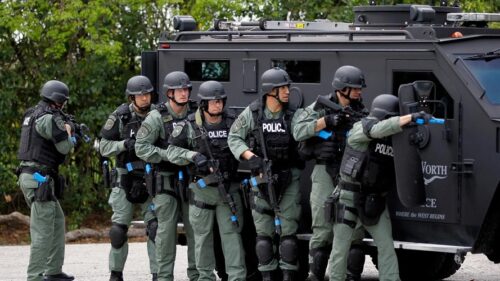
3.3.23 – Samuel Stebbins, 24/7 Wall St. via The Center Square
High-profile unlawful killings by police officers in recent years have put American law enforcement under intense public scrutiny. Outrage over abuses of power, most notably the murder of George Floyd, led many to advocate for radical police reform, with some going so far as to call for defunding the police.
Dismissed by elected officials across the political spectrum as an unworkable idea, the defund the police movement failed to gain meaningful traction with policy makers – many of whom have expressed support for police reform rather than complete disbandment. In his 2022 State of the Union Address, President Joe Biden stated in no-uncertain terms: “We should all agree the answer is not to defund the police. It’s to fund the police […] Fund them with the resources and training they need to protect our communities.”
In light of rising violent crime, grassroots support for the defund the police movement also appears to be slipping. An October 2021 survey conducted by the Pew Research Center found that 47% of American adults say they want increased police spending in their area, up from 31% in June 2020. State and local police spending totalled $128.2 billion in 2020, up from $122.6 billion the previous year – and if public sentiment is any gauge, that number will likely continue to rise.
According to data from the U.S. Census Bureau, state and local spending on police protection totaled $1.1 billion in Kansas in 2020, or about $361 per resident, the 18th highest per capita spending among the 50 states.
A total of 8,794 police officers were employed in Kansas in 2020. Adjusting for population, this comes out to about 300 officers for every 100,000 people, the sixth most among states.
Data on police protection spending is from Census Bureau’s 2020 State & Local Government Finance Historical Datasets and Tables, while data on police employment is from the U.S. Census Bureau’s 2021 Annual Survey of Public Employment. Per capita calculations were made using U.S. Census Bureau population data from July 2021.
| Rank | State | Per capita police spending, 2020 ($) | Number of officers in state, 2020 | Officers per 100,000 people, 2020 |
|---|---|---|---|---|
| 1 | California | 564 | 115,744 | 295 |
| 2 | Alaska | 554 | 1,963 | 268 |
| 3 | New York | 550 | 80,662 | 407 |
| 4 | Maryland | 492 | 17,917 | 291 |
| 5 | Nevada | 472 | 8,588 | 273 |
| 6 | Rhode Island | 468 | 3,090 | 282 |
| 7 | Florida | 468 | 62,604 | 287 |
| 8 | Illinois | 444 | 37,861 | 299 |
| 9 | New Jersey | 430 | 32,761 | 354 |
| 10 | Minnesota | 423 | 12,419 | 218 |
| 11 | Arizona | 406 | 19,949 | 274 |
| 12 | Wyoming | 401 | 1,862 | 322 |
| 13 | Colorado | 400 | 16,605 | 286 |
| 14 | Delaware | 394 | 2,570 | 256 |
| 15 | Oregon | 374 | 8,915 | 210 |
| 16 | Hawaii | 374 | 4,154 | 288 |
| 17 | New Mexico | 361 | 5,856 | 277 |
| 18 | Kansas | 361 | 8,794 | 300 |
| 19 | Connecticut | 359 | 9,408 | 261 |
| 20 | New Hampshire | 357 | 3,660 | 264 |
| 21 | Massachusetts | 346 | 19,923 | 285 |
| 22 | North Carolina | 346 | 30,721 | 291 |
| 23 | Montana | 344 | 2,617 | 237 |
| 24 | Ohio | 344 | 29,281 | 249 |
| 25 | Missouri | 344 | 17,991 | 292 |
| 26 | Vermont | 341 | 1,366 | 212 |
| 27 | Tennessee | 331 | 21,365 | 306 |
| 28 | Pennsylvania | 330 | 29,914 | 231 |
| 29 | North Dakota | 330 | 2,050 | 265 |
| 30 | Washington | 329 | 14,776 | 191 |
| 31 | Wisconsin | 326 | 14,966 | 254 |
| 32 | Louisiana | 326 | 16,206 | 350 |
| 33 | Texas | 320 | 79,745 | 270 |
| 34 | Virginia | 313 | 21,158 | 245 |
| 35 | Nebraska | 298 | 4,923 | 251 |
| 36 | Idaho | 292 | 4,416 | 232 |
| 37 | Michigan | 290 | 20,040 | 199 |
| 38 | Alabama | 289 | 14,290 | 284 |
| 39 | Oklahoma | 288 | 11,309 | 284 |
| 40 | Iowa | 287 | 7,061 | 221 |
| 41 | Georgia | 284 | 27,743 | 257 |
| 42 | Utah | 282 | 6,221 | 186 |
| 43 | South Carolina | 276 | 14,478 | 279 |
| 44 | Mississippi | 267 | 8,580 | 291 |
| 45 | South Dakota | 258 | 2,123 | 237 |
| 46 | West Virginia | 254 | 3,901 | 219 |
| 47 | Arkansas | 245 | 8,902 | 294 |
| 48 | Maine | 241 | 2,957 | 215 |
| 49 | Indiana | 236 | 15,633 | 230 |
| 50 | Kentucky | 182 | 9,680 | 215 |
Originally published on 247wallst.com, part of the BLOX Digital Content Exchange.
